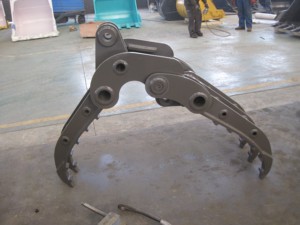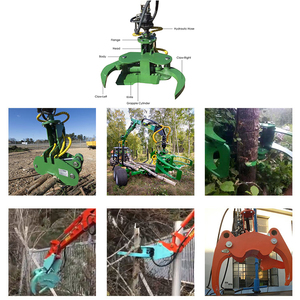
All categories
Featured selections
Trade Assurance
Buyer Central
Help Center
Get the app
Become a supplier

(1297 products available)































The extended grabber claw adjustable tool is a unique tool for professionals and hobbyists who need to grab hard-to-reach objects. The tool is divided into several types, each serving its own purpose. The following are some of the most popular types:
Hydraulic construction grabs use fluid power to operate. Hydraulic grabs use excavator hydraulic systems, generating immense power for large object handling and lifting. They suit big construction or mining operation requiring strength and durability. Moreover, they help in grabbing concrete, stones, and other structural debris during excavation.
Manual construction grabs generally use a lever or a hand-operated mechanism. The manual grabs close on the load with a hand pull, leveraging a few pounds to lift many. They suit small projects where work requires control. They are also appropriate in construction areas where limited lifting is necessary. Manual grabs can grab pipes, timbers, or small metalworks.
Mechanical construction grabs operate through an excavator's bucket tilt or a secondary hydraulic line. The mechanical grabs hold and release loads through bucket movement. They are advantageous where lower hydraulic power is sufficient. Mechanical grabs also suit demolition work involving large concrete blocks and old building materials.
Hydraulic construction grabs attach to existing machinery with ease, replacing other attachments. For example, an all-attachment grab can attach to excavators and other machinery to perform a different task. It is also ideal for companies without the space to house many different machines.
Electric construction grabs use electric power rather than hydraulics. They suit green building practices or where site power is available. These energy-efficient grabs help reduce the overall carbon emissions from construction projects. They are also used to grab and lift items like excavator buckets or building steel girders.
Construction grabs make site preparation easier. The extended grabber claw allows operatives to effortlessly manipulate items like stones, soil, and construction debris. Furthermore, hydraulic grabs excel in this area due to their capacity to handle large quantities. This improves site preparation efficiency.
During demolition, construction grabs handle risky tasks. For instance, mechanical grabs can easily manoeuvre large concrete slabs or remaining structural elements during demolition. They offer the strength and precision to manage heavyweight while improving safety.
The construction grab tools improve the handling of construction materials. For instance, hydraulic grabs reduce the manual labour needed to move heavy blocks, bricks, or steel. This is mostly in warehouses, construction sites, or at the supply level. Essentially, they help save time and lower workplace injury risks while boosting productivity.
In mining or quarrying operations, construction grabs help handle minerals or extracted debris. For example, hydraulic grabs are still preferred here due to their capacity to withstand harsh conditions and enormous workloads. Also, they are suitable for lifting stones, rocks, and other bulky materials used in mining.
Construction grabs are crucial to recycling operations focusing on waste materials' retrieval and sorting. With their versatility, a mechanical grab can easily separate wood, metal, and concrete waste. This enhances the efficiency and accuracy of recycling operations and promotes environmental sustainability on construction sites.
They are widely employed in transporting bulky and awkward cargo, including materials for building and civil infrastructure. For instance, electric and mechanical grabs are highly useful in managing containers, pallets, steel frames, poles, and other construction materials. Particularly, hydraulic grabs provide smooth movements while improving safety and reducing the risk of damage.
Size
This extended grabber claw adjustable tool comes in multiple sizes. There are lightweight models for small vehicles like ATVs. Large sizes are for full-sized cars or trucks. Regardless of vehicle size, there is a proportionate grabber size to fit the wheel outlines.
Weight capacity
The extended grabber tool has varying weight capacities, depending on the model. Small grabbers can carry up to 15 pounds. Larger ones can pick and pull over 40 pounds. Users should match the load capacity of each grabber to the load they intend to carry for optimal performance.
Material
Many grabbers have steel claws to offer superior strength and durability. Some have rubber tips for better grip and less damage to the load. Plastic models are available for those who require something lightweight yet hardy enough for lighter tasks.
Adjustability
Some models allow the width of the claw to be adjusted. This makes them very handy for carrying various loads. Users can simply twist a knob or lever to change how wide or narrow the claws are. This makes it possible for the grabber to handle different item shapes and sizes.
Open the vehicle's wheel
The first step in installing the extended grabber claw adjustable tool is to remove the centre caps. The hub caps should be carefully unscrewed or pried off. This action leaves the exposed and accessible lug nut area.
Attach the grabber wheels
Once the wheel is ready, the next step is to position the grabber onto the wheel. People should ensure the grabber's straps align with the lug nut holes. Each grabber has left and right sides labelled for ease of installation. The users should ensure they are using the correct side.
Secure grabber
To secure the grabber, users should slide the grabber against the wheel. Then, using provided bolts, fasten the grabber to the wheel. As they do this, ensure they don't fully tighten the bolts. This allows for minor adjustments in case the grabber is not properly positioned.
Lower the vehicle
After securing the grabber, it's time to lower the vehicle. Slowly lower the vehicle until it rests partially on the grabber. This keeps the grabber stable as adjustments are made. Add a safety stand under the vehicle just in case the lowering mechanism fails.
Adjust for fit
This step ensures the grabber is fit for use. Properly tighten the grabber's straps against the wheel for a secure fit. Lower the vehicle fully to allow even weight distribution. Finally, check the tightness of all bolts. Go on a short test run to confirm stability before doing actual tasks.
Regular maintenance
The extended grabber claw adjustable tool's maintenance begins with regular inspections. Users should do frequent visual checks for signs of wear and tear. Typical indications include rust, cracks, or bends. Operating while damaged further damages other tools and the load. They should also lubricate all the moving parts occasionally to smooth operation and reduce wear-out.
Hydraulic fluid checks
The hydraulic construction grabs should be among the tools operating using hydraulic fluids. Users should ensure proper maintenance checks are done on hydraulic fluid levels. Low fluid levels cause strain on the hydraulic system, resulting in damage. Also, dirty hydraulic fluid is hazardous since it causes system clogging. They should clean or replace it as required by regulations or manufacturers.
Follow the manufacturer's guidelines
Each piece of equipment comes with a manual that details usage, maintenance, and repair guidelines. The manual usually comes with complete care instructions. It also outlines the maintenance schedule. Following this schedule helps prevent unforeseen breakdowns. Moreover, using mechanical grabs for purposes other than intended voids warranties and can give rise to risky situations.
Watch out for signs of wear
Construction grab tools can experience wear after long use. Common areas prone to wear out are the grab claws and pivot points. Users should replace worn-out parts immediately. Continuing use destroys worn-out parts and poses many dangers to the employees.
Manufacturers of hydraulic construction grabs use hydraulic fluids with a high viscosity index (V1). Fluids with high V1 ensure consistent operation in varying temperatures. Fluids help prevent wear by providing a lubricating film between the metal components in motion.
Quality construction hydraulic grab parts include pumps, cylinders, and motors. They work together well to generate high forces. High-quality hydraulic pumps produce high fluid pressures necessary for intense grabs. Large-capacity hydraulic cylinders convert these pressures into powerful pushes.
Manufacturers make grab claws of high-tensile-strength material, usually tempered steel. These materials include chrome-molybdenum or wear-resistant alloy steel. Strong materials resist bending or breaking under heavy loads. They also ensure they retain sharp edges over time to grip better.
Durable composite bushings often line the pivot points. This reduces metal-to-metal contact during long uses. Bushings are made of materials that won't wear out quickly, even under heavy cycles. Moreover, they are engineered to provide maintenance-free operation. This feature ensures the grab is always ready without frequent downtime.
Weather and environment-resistant hydraulic grabs are specifically designed and built for outdoor use. Chrome plating or stainless steel are the typical finishes used to protect against rust and corrosion. Manufacturers apply these coatings to extend equipment life. Hence, quality components ensure reliable performance within extreme temperatures.
The extended grabber claw adjustable tool has components made of high-quality plastics or metal. These materials are sturdy yet light. The materials ensure the grabber can carry light loads but still last long. Users should take care of the grabber by storing it in dry places when not in use. It should also be cleaned frequently to maintain its quality.
A1. Manual construction grabs are suitable for this purpose. They are lightweight and versatile, making them appropriate for small projects where the load requires precision to lift. These grabs are most suitable for handling construction materials like pipes and timber.
A2. Yes, electric grabs are an efficient alternative to hydraulic grabs. They are especially good for eco-friendly construction practices. Their power source contributes to reducing carbon emissions. They are also less ideal for heavy-duty tasks, but they nonetheless improve longevity and lower operating costs.
A3. Grab manufacturers use various materials for different grabs. Steel grabs are ideal for heavy-duty tasks due to their strength. Meanwhile, hydraulic grabs have parts made of high-tensile steel. This is because this type of steel is wear-resistant. Some manufacturers also make mechanical grabs with cast iron. Cast iron is sturdy and resistant to corrosion.
A4. For grabs to last longer, users should regularly maintain them. They should inspect the equipment frequently for signs of wear out. Also, lubricate moving parts and replace worn components. Additionally, keeping the grab clean and dry will prevent rust and corrosion. Finally, ensure there is proper storage for the machinery when not in use.
A5. Construction grab tools help minimise injuries. In particular, hydraulic grabs are suitable for handling dangerous and bulky objects like concrete slabs during demolition. They reduce workers' direct contact with hazardous materials. Moreover, they have the strength to accomplish tasks that would require more effort from workers.